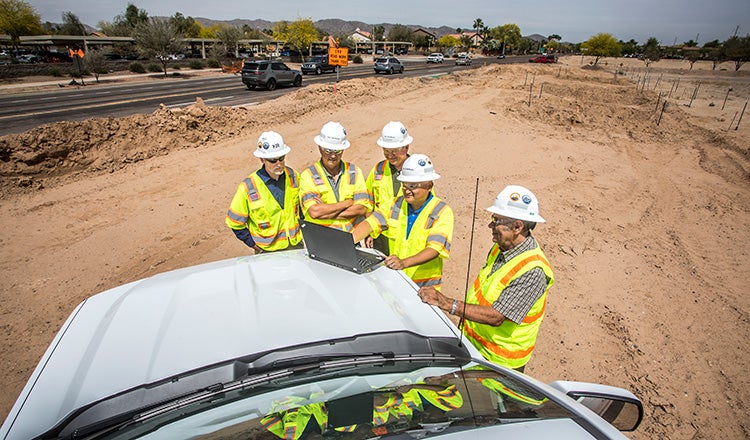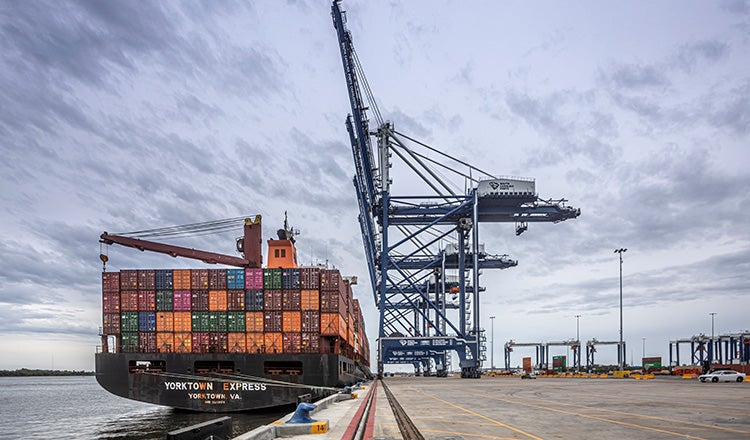
Experts Talk: Unpacking Program Management Benefits with Erin Slayton
Experts Talk is an interview series with technical leaders from across our transportation program.
Delivering Big Picture Advantages for Owners and Communities
Program management is not a new concept in our industry but its usefulness in today’s world of aging infrastructure, funding constraints and ever-increasing stakeholder expectations is greater than ever. Asset-intensive infrastructure capital programs come in all shapes and sizes and need a range of services that are flexible and adapted to the unique needs of each owner and program.
In this interview, Erin Slayton P.E., our transportation program management services director, explores key points that are vital to successful program management. She shares wisdom on tailoring resources suited to each owner’s situation. Drawing on her deep background on complex, multibillion-dollar programs, she sheds light on how to approach program management to achieve its potential.
Q. What are some of the misperceptions or myths about program management that owners have asked you about?
A. The most common misperception is that it’s typical “project” management, just on a larger scale. On the contrary, the risks are different, the considerations are different. A $10 billion program isn’t just a bigger $100 million project. You don’t just scale up your delivery approach, you think it through differently.
We define program management as planning and delivering interrelated projects and/or services, managed by an integrated multidisciplinary team in a coordinated way, to achieve an overarching outcome and obtain benefits and control that could not be obtained by managing them individually.
When we are delivering a program of projects, the overarching goal we are looking to achieve is more than the sum of its parts, so we look at the big picture of how each of the individual projects impacts the goals of the overall program. Using a programmatic approach helps us manage the risks by looking at all of the individual project risks together in the overall program to find the “right” and most efficient and effective risk profile for the program.
Q. It sounds expensive. Exactly how does program management add value?
A. A program management approach is scalable to the needs of the program, and frequently hinges on upfront attention to identifying risks, using project controls tools, and maximising staff efficiency. The goal is to invest time early to develop an efficient team structure and to manage risks that may get missed without a programmatic approach. That upfront effort pays off over the life of the program. It helps the project team see challenges before they happen.

South Mountain Freeway in Phoenix is a great example where HDR’s program management team collaborated with the owner on an approach that allowed the freeway to open three years earlier than if it had been built using a traditional approach, with a cost savings of more than $100 million. Our team co-located with a core group of Arizona DOT staff, working as a seamless extension of their staff through all phases of the program. We fostered an environment where, at each critical junction of the project, we had the right people making the right decisions at the right time. The team had a robust project controls system, communicated through dashboards, and the owner embraced the information, using it as the basis for weekly team meetings. We could see the challenges before they became full-blown problems so we could mitigate most issues before they resulted in a claim. We had information easily presentable to executive leadership and to FHWA. It was a clean way of managing the inevitable challenges.
Q. When is the right time and what are the first steps an owner should take to initiate program management?
A. The best benefits are gained by bringing together a small advisory team as early as possible to help determine the components and structure of the program, and possibly the delivery methods. At the beginning we need a few people who are very strategic — who have experience delivering similar programs — to help develop the plan and approach. As we prepare the plan, the team can selectively add people who bring value on key elements.
HDR’s work as technical advisor for the Ontario Line Subway in Toronto — a 16-kilometer line involving multiple contractor teams and multiple delivery methods is an example of where we used this approach. We set up and managed an integrated program management approach in collaboration with the owner, providing information/data to support key decisions, streamlining efficiencies and communications, and developing a risk management process. We started with a select, small team and added carefully chosen expertise as the project progressed.

Q. What services are included in program management at HDR?
A. Our role is often to provide whatever the owner needs whenever the owner needs it. That means we provide a very wide range of services, but generally separate them into four buckets:
- Program framework, including setup of a program’s governance, management plan and organisation
- Program support, including community engagement, right of way, environmental permitting and data acquisition
- Program administration, including cost estimating, project controls, dashboards and risk management
- Program delivery, including conceptual engineering, design reviews, delivery method selection, contract administration and construction management
We pride ourselves on “one stop shopping.” We have both a deep bench of expertise in-house combined with long-term industry relationships that we can call upon for whatever our clients require.
Q. That’s a lot of services. Among those, what’s been in high demand recently? What trends are you seeing in the industry?
A. Progressive delivery is hot right now. Owners are becoming more interested in whether a progressive approach such as progressive design-build or construction manager/general contractor (CM/GM) makes sense for their projects. Using risk-based modeling — and informed by our years of experience with these methods — we can help owners determine if these approaches are a good fit based on their specific cost and schedule goals.
In large megaprograms involving many projects, the procurement decision process often involves a combination of methods. On the Carolina Crossroads program in South Carolina, for instance, different phases of the program are being delivered through a combination of design-bid-build and design-build projects. On the Ontario Line, the program is using four different delivery methods. In each case, we helped the owner determine which mix of methods made the most sense to meet the program’s overall objectives and schedule.

Q. What makes HDR’s approach successful?
A. We’re in it for the long term. Programs can run over years or decades even, and over that time organisations, communities and even programs will evolve. I’m proud that we have a long track record of standing by our clients through the challenges and the successes to find the best solutions together for our communities. We help our clients deliver the program so they can fulfill their commitments to their constituents, even when things don’t go according to the initial plan. That has meant working through finance plans and new funding approaches, pivoting away from certain delivery models as their popularity wanes in certain situations, navigating reorganisations in our client’s leadership teams, just to name a few. No matter what, we are partners who work in lockstep with our clients and program teams.
Q. What sets that approach apart in the industry?
A. It has to be HDR’s “Listen First” value. It makes a big difference in how the team interacts because we start from an assumption of trust and partnership and listening, focused on solving problems together. Combine these soft skills with the depth of services we talked about earlier, and that’s a very powerful combo.
I always say, “Leave your logo at the door.” Especially for large integrated teams, co-located with an owner, we’re all working for the good of the team and the program and the community. A very strong element of our approach is this attitude that we’re going to be there with you, finding the right solutions to keep your program moving forward while managing the risks at every step of the way. We’ve proven many times that together, we make great things possible.

Inspiration and Advice
Q. How did you get started in program management?
A. I’ve always been fascinated by bridge engineering, especially growing up near the infamous Tacoma Narrows Bridge. I studied structures in college, interned on the Tacoma Narrows Bridge Project and was on a career path to be a bridge engineer. I got the opportunity to work for the Seattle Popular Monorail Authority and realised I really enjoyed the exposure to all the parts and pieces of a major project — from negotiations with contractors to conversations with the public.
From that, I realised that understanding the bigger picture was a compelling way to bring value to projects. I was hooked.

Q. What advice do you have for anyone considering a career in program management?
A. A lot of people can be intimidated by a billion-dollar-plus program, and I understand why delivering a big program can feel scary. What’s exciting is leaning into those unknowns and working through them to achieve the overall goals of the program.
The big-picture management approach that’s required for a billion-dollar program is a completely different skillset than the detailed approach required to be successful in design or even in managing smaller projects. The best way to learn to deliver these large programs is through experience gained on the job.
I’m grateful for my mentors and have reflected on how instrumental they have been in my growth. I can think of so many examples where intentionally providing opportunities for people has built careers, and this benefits the person, the organisation and the community.
To early career people — seek out these expert mentors and ask lots of questions. Don’t be afraid to try new things, even if it’s totally different than what you thought you’d be doing with your career. If you don’t like it, no big deal — go back to what you were doing before or try something else! But you’ll never know unless you try.
To leaders — watch for opportunities to intentionally set out stepping stones to prepare younger staff to experience new situations, see the bigger picture, and grow their readiness for responsibility.
Each Experts Talk interview illuminates a different aspect of transportation infrastructure planning, design and delivery. Check back regularly for new insights from the specialised experts and thought leaders behind our award-winning, full service consulting practice.




